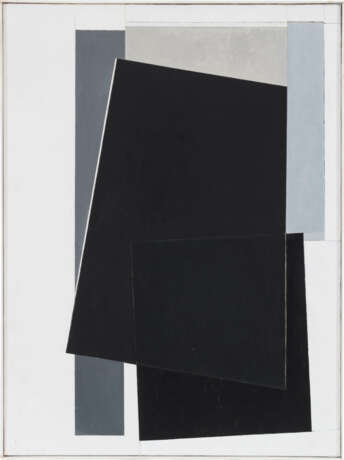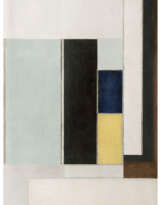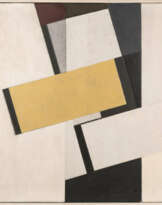Heinrich Siepmann (1904 Mülheim an der Ruhr - 2002 ebenda) (F)
26.11.2022 13:00UTC +01:00
Classic
Starting price
1400EUR € 1 400
| Auctioneer | WETTMANN | Auktionshaus an der Ruhr |
|---|---|
| Event location | Germany, Mülheim an der Ruhr |
| Buyer Premium | 30% |
Archive
The auction is completed. No bids can be placed anymore.

ID 847285
Lot 62 | Heinrich Siepmann (1904 Mülheim an der Ruhr - 2002 ebenda) (F)
Estimate value
€ 1 400
'B 9/1984', Öl auf Leinwand, 100 cm x 75 cm, signiert, 84 datiert, partiell fleckig, Provenienz: Die Authentizität wird durch den Sohn Heinrich Siepmanns garantiert; Literatur: Wvz. Ullrich 803, mit farb. Abb. S. 315; Ausst.-Kat. Kunsthalle Recklinghausen, "Heinrich Siepmann - Gemälde und Collagen der achtziger Jahre", 1998, S. 40, mit schwarz-weiß Abb.; Ausst.-Kat. Museum Bochum, "Heinrich Siepmann - Retrospektive", Nr. 125, mit schwarz-weiß Abb.; Ausstellungen: März-April 1988, Kunsthalle Recklinghausen; September-Oktober 1988, Galerie hw, Feldafing; März-April 1989, Städtische Galerie Ravensburg; Juli 1989, Biuro Wystaw Artystycznych w Krakowie (BWA Krakau); November 1989 - Januar 1990, Galerie Winkelmann, Düsseldorf.
1904 in Mühlheim an der Ruhr geboren, gehörte Heinrich Siepmann zur sogenannten zweiten Generation der Konstruktivsten. Der Konstruktivismus als Stilrichtung in der Malerei und Architektur entstand im revolutionären Russland in der ersten Hälfte des 20. Jahrhunderts als völlig gegenstandslose, rein auf geometrische Formen basierende Kunstrichtung. Sie war maßgebend für die niederländische Bewegung "De Stijl" und beeinflusste viele bildende Künstler in Deutschland, wie auch die Entwicklung und künstlerische Ausrichtung des Bauhauses. 1948 wurde Siepmann Mitbegründer der Künstlergruppe "junger Westen", die wichtige Impulse für das deutsche Informel lieferte. Die Gruppe setzte sich zum Ziel, den während der Zeit des Nationalsozialismus verlorenen Anschluss Deutschlands an die Kunst der Moderne wiederherzustellen. Angeregt von seinem Kontakt zum deutschen Informel entwickelt Siepmann innerhalb des Konstruktivismus eine eigene unverwechselbare Formensprache, die sich im Laufe seiner Karriere immer in einem Spannungsverhältnis zwischen geometrischer Strenge und freier Abstraktion bewegte. Siepmann blieb seiner Heimatstadt Mülheim an der Ruhr zeitlebens verbunden. Als er im Jahre 2002 dort verstarb, hinterließ er ein Oeuvre, dass über 1200 Gemälde, sowie zahlreichen Collagen und Skulpturen umfasst.
Heinrich Siepmann (1904 Mülheim an der Ruhr - 2002 ibid.) (F)
'B 9/1984', oil on canvas, 100 cm x 75 cm, signed, dated 84, partially stained, Provenance: the authenticity is guaranteed by Heinrich Siepmann's son; Literature: Wvz. Ullrich 803, with col. ill. p. 315; Exhibit-Cat. Kunsthalle Recklinghausen, ''Heinrich Siepmann - Gemälde und Collagen der achttziger Jahre'', 1998, p. 40, with black and white ill. Museum Bochum, ''Heinrich Siepmann - Retrospective'', no. 125; exhibitions: March-April 1988, Kunsthalle Recklinghausen; September-October 1988, Galerie hw, Feldafing; March-April 1989, Städtische Galerie Ravensburg; July 1989, Biuro Wystaw Artystycznych w Krakowie (BWA Krakow); November 1989 - January 1990, Galerie Winkelmann, Düsseldorf.
Heinrich Siepmann, born in 1904 in Mülheim an der Ruhr, belonged to the so-called second generation of Constructivists. Constructivism as a style in painting and architecture emerged in revolutionary Russia in the first half of the 20th century as a completely non-objective art movement based purely on geometric forms. It was decisive for the Dutch movement ''De Stijl'' and influenced many visual artists in Germany, as well as the development and artistic orientation of the Bauhaus. In 1948 Siepmann became a co-founder of the artists' group ''junger Westen'', which provided important impulses for German Informel. The group set itself the goal of restoring Germany's connection to modern art, which had been lost during the National Socialist era. Inspired by his contact with German Informel, Siepmann developed his own distinctive formal language within Constructivism, which throughout his career always moved in a tension between geometric rigour and free abstraction. Siepmann remained close to his hometown of Mülheim an der Ruhr throughout his life. When he died there in 2002, he left behind an oeuvre that includes over 1200 paintings, as well as numerous collages and sculptures.
| Artist: | Heinrich Siepmann (1904 - 2002) |
|---|---|
| Auction house category: | Paintings and mixed media |
| Artist: | Heinrich Siepmann (1904 - 2002) |
|---|---|
| Auction house category: | Paintings and mixed media |
| Address of auction |
WETTMANN | Auktionshaus an der Ruhr Friedrichstraße 67-67a 45468 Mülheim an der Ruhr Germany | ||||||||||||||
|---|---|---|---|---|---|---|---|---|---|---|---|---|---|---|---|
| Preview |
| ||||||||||||||
| Phone | +49 (0)208 3059081 | ||||||||||||||
| Fax | +49 (0)208 4391735 | ||||||||||||||
| Buyer Premium | 30% | ||||||||||||||
| Conditions of purchase | Conditions of purchase | ||||||||||||||
| Business hours | Business hours
|













